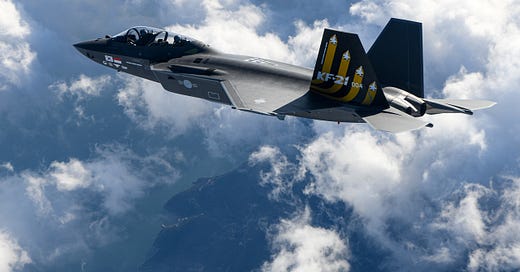Korea Aerospace Industries Secures Second KF-21 Deal, Anchoring South Korea’s Shift Toward Indigenous Air Power
Korea Aerospace Industries (KAI) has signed a second major agreement with South Korea’s Defence Acquisition Program Administration (DAPA) to supply 20 additional KF-21 Boramae fighter jets, in a deal valued at 2.39 trillion won ($1.76 billion). This follows the June 2024 contract for the initial production of 20 units, marking a critical phase in the operational rollout of the nation’s first domestically developed 4.5-generation multirole fighter. With deliveries expected to begin in the second half of 2026, the deal consolidates the KF-21’s status as the backbone of South Korea’s next-generation air combat fleet and as a strategic industrial asset within the broader Indo-Pacific security environment.
The KF-21 programme symbolises a major inflection point in South Korea’s defence-industrial trajectory, moving the country beyond its historical reliance on foreign suppliers—primarily the United States—for air power capabilities. Intended to replace ageing F-4, F-5, KF-16, and even some F-15K aircraft, the twin-engine KF-21 is designed for long-term platform sovereignty, modularity, and future integration of indigenous weapons systems. The aircraft is powered by General Electric’s F414 engines but has already begun trials with locally developed long-range air-to-surface missiles, indicating an ambition to transition toward full strike autonomy. The incorporation of AESA radar systems by Hanwha Systems further enhances domestic vertical integration.
Beyond its national relevance, the KF-21 is emerging as a credible export contender in a market historically dominated by U.S., European, and Russian platforms. Indonesia, a co-development partner, recently reaffirmed its participation with a 600 billion won contribution, while the United Arab Emirates and other countries have expressed interest in future sales. This not only diversifies Korea’s strategic partnerships but also aligns with Seoul’s broader objective of becoming a net exporter of high-value defence technologies. The fighter’s competitive cost structure, open architecture, and compatibility with a wide range of munitions enhance its appeal to mid-tier powers seeking advanced capabilities without full strategic dependency on the U.S. or China.
The industrial logic behind the programme is equally compelling. Alongside the airframe contract, DAPA has signed a 623.2 billion won agreement with Hanwha Aerospace for the supply of F414-based engines, bringing total propulsion contract values to 1.18 trillion won. In parallel, Hanwha Systems closed a deal for 124.8 billion won to provide additional AESA radar units. These contracts distribute technological and financial risk across South Korea’s leading aerospace and defence firms while fostering a layered industrial ecosystem capable of sustaining long-term support, upgrades, and innovation cycles. This model aligns with South Korea’s national strategy of defence self-reliance and economic multiplier effects through high-tech manufacturing.
Strategically, the KF-21 serves not only as a platform for air superiority and precision strike but also as a symbol of geopolitical positioning. In a region increasingly defined by Sino-American rivalry, Seoul’s ability to field and export indigenous systems enhances its strategic autonomy while reinforcing its status as a reliable security partner to Western allies. At the same time, the programme allows South Korea to engage in selective security diplomacy—deepening ties with Southeast Asia, the Middle East, and beyond—without compromising its alliance with Washington. The KF-21 thus functions as both a military asset and a tool of strategic signalling.
In conclusion, the second KF-21 procurement contract underscores the aircraft’s transition from prototype to pillar of South Korea’s future air power and industrial base. As deliveries approach and testing expands, the Boramae project stands as one of Asia’s most ambitious aerospace undertakings—combining technological innovation, economic strategy, and geopolitical calculus. With successful integration of indigenously developed subsystems and continued export diplomacy, the KF-21 is poised not only to redefine South Korea’s air force, but also to reshape the competitive dynamics of the global fighter market.




